By Taylor Kolste

Shortly after the Super Bowl, I will be releasing my first book, Breaking Down the 2018 L.A. Rams Offense. It should be released the weekend following the Super Bowl.
UPDATE: The book is now available: https://www.amazon.com/dp/1794188207.
This preview will contain a few excerpts from the book to hopefully give the reader a good idea of what the book will be like. Hopefully, these excerpts can also give you some context on the Rams offense leading into the Super Bowl. There will be updates made to the book based on the Super Bowl, so the sections shown here will likely be slightly different when the book is released, but this is very close to what the final product will look like. There are 26 of the 359 pages shown below. The rest of the book follows the same structure to what is shown in the preview.
PREVIEW:
TABLE OF CONTENTS
INTRODUCTION – 1
CHAPTER 1: PERSONAL CHARACTER, LEADERSHIP, & TEAM CULTURE – 3
- Personal Character – 5
- Leadership – 11
- Team Culture – 18
CHAPTER 2: INTRO TO RAMS OFFENSE – 22
- Offensive Philosophy – 22
- Identity – 23
- Tempo-Use – 27
CHAPTER 3: RUN GAME – 32
- Fly Sweep – 33
- Mid Zone – 45
- Outside Zone – 61
- Inside Zone – 63
- Duo – 70
- Toss Sweep – 76
- Short Trap – 81
- Long Trap – 84
- Wham – 86
- Quasi-RPOs – 88
- Other Runs – 91
CHAPTER 4: PLAY-ACTION PASS GAME – 99
- Play-Action – 99
- Naked Boots – 164
- Half-Boots – 179
CHAPTER 5: DROPBACK PASS GAME – 208
- Quick Game – 208
- 5-Step Passing Game – 222
- 7-Step Passing Game – 315
- Vertical Passing Game – 339
CHAPTER 6: SCREEN GAME – 351
INTRODUCTION
The turnaround of the Los Angeles Rams under head coach, Sean McVay, has been truly remarkable. The Rams went from 4-12 in 2016 with, statistically, the worst offense in the NFL in nearly every category to winning a NFC West championship at 11-5, while featuring one of the most dynamic offenses in the league the next season under McVay. In McVay’s second season, the Rams again won the NFC West and appeared in the Super Bowl. The following table shows the turnaround of the Rams’ offense from 2016 under the previous staff to 2017 and 2018 under McVay:
| Year | Yards Per Play (Rank) | Yards Per Game (Rank) | Points Per Game | (Rank) | ||||||||||||||
| 2016 | 4.4 (32) | 262.7 (32) | 14.0 (32) | |||||||||||||||
| 2017 | 5.8 (10) | 361.5 (10) | 29.9 (1) | |||||||||||||||
| 2018 | 6.3 (3) | 420.8 (1) | 32.4 (2) |
The goal of this book is to take an in-depth look at the schemes that helped the Rams be successful in the 2018 season with the purpose being so that other coaches can learn and use that knowledge to increase their own teams’ chances of success.
While this book will focus on the Rams’ scheme, it would be incomplete without discussing McVay’s character and leadership that have helped him be successful as a coach, and the culture that he and his staff have created. The first chapter of this book will look at McVay’s character and leadership and the Rams’ culture based on the information available online. In all honesty, personal character, leadership, and team culture all precede scheme and should be studied just as much as the X’s & O’s of the game, however, being on the outside, there is limited access to studying this aspect of McVay’s coaching and of the Rams’ team, so this topic will be limited to the first chapter. Since we have full access to the film on the Rams’ offense, we will be able to look at the complete picture of their offensive scheme. The scheme section of this book will then analyze each of the following aspects of the Rams’ offense:
- Intro to Rams Offense (General Philosophy, Identity, ETC.)
- Run Game
- Play-Action Pass Game
- Dropback Pass Game
- Screen Game
CHAPTER 1 (EXCERPT)
PERSONAL CHARACTER, LEADERSHIP, & TEAM CULTURE
“Sean McVay is a genius.” This is a sentiment that has been echoed by many people. This praise of McVay mirrors that of Bill Walsh when he was first building his dynasty in San Francisco. In Walsh’s book, The Score Takes Care of Itself, he has a section titled “Don’t Let Anybody Call You a Genius” where he states that “when the “Genius” title turned on me, I backed away from it as far as I could get.” I would guess that McVay would express similar feelings to the ‘genius’ label. While McVay is definitely a smart guy, I believe calling him a ‘genius’ is misguided. While McVay and his staff may have created a ‘genius’ scheme, crediting all of this to McVay’s natural intellect ignores his work ethic and other character traits that have led to his success. This also ignores McVay’s leadership abilities and does not recognize the rest of his staff for their contributions in developing the scheme. In addition to this, the team culture of the Rams, which stems from McVay and his staff’s leadership, plays just as big of a role in the success of the team as the scheme does. Former Michigan head football coach, Bo Schembechler, famously said, “I’ve always believe eye-popping innovation is not as important as perfect execution.” The way the Rams think, the attitude they take towards their work, and the way they go about their day-to-day business, in other words, their culture, is what allows them to execute the scheme to the best of their abilities. So, as the chart shows below, everything starts with the leader’s personal character.

Former Navy SEAL, David Goggins, once said that “you have to be a good individual before you can be a good team player” or leader. The type of a person that someone is leads to the type of leader they are, which will affect their ability to develop their scheme alongside their staff. The type of leader a coach is will show itself in the culture that the leader develops within the team, and the culture is what will ultimately determine how well the team can execute the scheme. So, throughout this chapter, we will first look at the personal character of McVay, mostly told through the stories of people who have been around him. Secondly, we will look at how his character allows him to be the type of leader that he is and how those around him respond to his leadership. Thirdly, we will look at the culture he has developed for the Rams, through McVay’s own words.
…
CHAPTER 2 (EXCERPT)
INTRO TO RAMS OFFENSE
…
OFFENSIVE PHILOSOPHY
Sean McVay has described his own offense as ‘deceptively complex.’ The Rams do not run a ton of schemes and do not use very many formations, but much of what they do offensively is series-based, meaning that they run a lot of schemes that look the same and work off of each other. Tony Romo summed it up pretty well when broadcasting their week 10 matchup with Seattle, “It’s almost simple, but brilliant. Now they fake the exact play they just ran… it’s really impressive how McVay runs so few plays but it’s impossible to stop them because he does 7 things off the exact same look.” As Romo said, it makes their offense really tough to stop because if the defense is gearing up to stop one play, they can just run another that looks the same but is designed to counter the defense’s response to the original play. In The Art of War, which is generally considered one of the greatest pieces ever written on military strategy, Sun Tzu describes a similar philosophy. Sun Tzu writes:
“All warfare is based on deception… The spot where we intend to fight must not be made known; for then the enemy will have to prepare against a possible attack at several different points; and his forces being thus distributed in many directions, the numbers we shall have to face at any given point will be proportionately few. For should the enemy strengthen his van, he will weaken his rear; should he strengthen his rear, he will weaken his van; should he strengthen his left, he will weaken his right; should he strengthen his right, he will weaken his left. If he sends reinforcements everywhere, he will everywhere be weak. Numerical weakness comes from having to prepare against possible attacks; numerical strength, from compelling our adversary to make these preparations against us.”
…
Note: Before getting into the next few chapters, there are a few things worth mentioning about the book:
- Much of what is written throughout the rest of this book is based on film study, so I may be off on a few things, but I do believe this book gives the reader an accurate picture of the Rams’ offense.
- This book includes all of the Rams base schemes ran in 2018, any schemes that were ran more than a few times, and any miscellaneous plays that were successful (ie: if a play was only ran once, but it went for an 80-yard touchdown, it was included in the book. If a play was only ran once and it resulted in a loss of 5, it was not included.)
- I tried using mostly generic terminology and for the most part, avoiding the specific terminology when referring to plays that the Rams use. You may use different terminology then what is used in this book to identify different concepts, but much of the terminology is just semantics and does not matter much as long as it is consistent.
- All play diagrams used in this book were created using Microsoft Visio. Microsoft Visio is available through Microsoft.com. Used with permission from Microsoft.
- The scheme section of this book will be accompanied by film clips that are posted at:
https://rileykolstefootball.com/rams-film-clips/
The book is written in a way where it is not necessary for you to view the film clips as you read, but they could be a helpful tool as you go through this book. Several of the diagrams will include a video label that will correspond a film clip on the link listed above. The majority of the clips are of the Rams from the 2018 season, however, I also included game clips from the 2017 season in addition to clips from other NFL teams to give a more complete picture of some of the concepts.
*** For the purposes of this article, the videos have just been inserted below the diagrams.
CHAPTER 3 (EXCERPT)
RUN GAME
…
MID ZONE
The base run for the 2018 Rams was the mid zone. Mid zone accounted for 46.9% of their run game in the 2018 season and is what they based the majority of their play-action game off of. Mid zone is essentially an outside zone play with the playside tackle blocking the play like inside zone. Because the playside tackle is trying to drive the EMLOS out rather than reach him, this bumps the running back’s read in. Below is a diagram of the traditional outside zone reads for the running back:
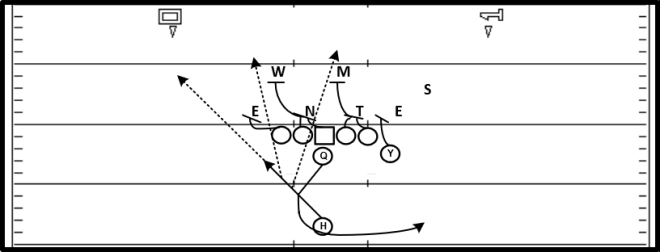
In the traditional version of outside zone, the running back will aim at the butt of the ‘ghost’ tight end (since this is a weakside run and there is no tight end). He will read the block on the defensive end first, and if the defensive end is reached, meaning if this defender’s helmet is on the inside of the blockers’, then he will ‘bounce’ the ball to the perimeter. If the defensive end maintains his outside leverage, the back will then shift his eyes to the defensive tackle. If the defensive tackle is reached, he will ‘bang’ the ball in between the end and tackle. If the tackle is not reached, he will ‘bend’ the ball back behind the playside defensive tackle. Note that the angles drawn in the diagram above aren’t necessarily realistic since the line will be moving horizontally, so the ‘bend’ cut-back is more of a cut-up than a cut-back. Below is a diagram of the running back’s reads on mid zone:
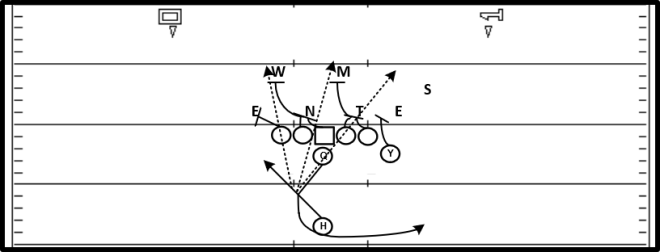
As I mentioned earlier, the mid zone blocking scheme is the same as outside zone for everyone except for the playside offensive tackle. The running back’s aiming point remains the same as outside zone as he is still trying to stretch the defense horizontally, but his reads are now bumped in 1 defensive lineman. Now that the playside tackle is not trying to reach the end, the running back will start his read on the playside defensive tackle. His second read now becomes the backside defensive tackle if the first defender is not reached. Because the ‘bounce’ read is eliminated, the ball can hit all-the-way behind the backside defensive tackle (again, the angles shown in the diagram will be more vertical in real life due to the horizontal movement of the line). This simple adjustment increases the effectiveness of the scheme because it increases the chances that the ball will get to the open space that the defense gives up. On the majority of weakside outside zone plays, the defensive end is not reached, and the ball is cut-up anyways. Many times, there is an open cut-up lane behind the backside defensive tackle but this would require a 3rd read from the running back, therefore, he would not be able to get to this area before it is closed by backside pursuit. So, by eliminating the ‘bounce’ read, the offense is giving it’s back a better chance to hit open lanes on the backside. Really, the offense is just trying to stretch the defense laterally so that the ball can hit behind the flow of the defense.
Based on the information I have, I believe that the Rams still refer to this as an outside zone scheme (many other coaches also refer to it as wide zone), but for the purposes of this book, I believe it gives the reader a better understanding of their offense by calling this scheme ‘mid zone’ based on the differences mentioned above. So, for the rest of this book, the play will be referred to as mid zone if the playside tackle is blocking the end out, and outside zone if the tackle is trying to reach this defender.
As was the case with nearly the entire Rams running game, they exclusively ran mid zone from under center. This helps them for a couple of reasons. First, the back is able to get downhill quicker, therefore making it easier for him to hit the backside cut-up lanes within the timing of the scheme. Second, it helps the offense hide the ball more, and as I mentioned before, the Rams used a ton of play-action passes, and the majority of them worked off of this run-action.
The blocking scheme upfront and the back’s aiming point were always the same, but the Rams had a few different ways in which they could run this scheme. Below is a chart showing the statistics of these different variations:
| Play | Plays | Yards | Yards Per Play | Touchdowns |
| MZ Cap | 48 | 260 | 5.42 | 4 |
| Fake Crack MZ Cap | 77 | 429 | 5.57 | 5 |
| MZ Cap FS TE | 28 | 211 | 7.54 | 0 |
| MZ Split | 30 | 128 | 4.27 | 2 |
| MZ Split Fake Reverse | 10 | 92 | 9.2 | 2 |
| MZ (4-Wide) | 4 | 11 | 2.75 | 0 |
| Fly MZ Cap | 11 | 42 | 3.82 | |
| Fly MZ Split | 21 | 121 | 5.76 | 0 |
MZ CAP
The most frequent version of mid zone that the Rams ran in 2018 is what I will refer to as ‘Mid Zone Cap.’ ‘Cap’ just refers to the tight end on the backside blocking the backside defensive end.

(Video 12)
Since they always ran this play towards the weakside of the formation, they would normally have good numbers at the point of attack. Most defenses also typically place the 3-technique to the strongside of the formation, so they would normally get to run this play towards the 1-technique. As the diagram above shows, this gives the offense a nice bubble to run to in between the 1-technique and the defensive end. This also allows the offense to get a double-team on both the frontside and backside of the play.
…
CHAPTER 4 (EXCERPT)
PLAY-ACTION PASS GAME
…
NAKED BOOTS
The second phase of the Rams play-action game is their naked boot game. On the majority of the Rams boot plays, they would sell mid zone away from the boot with a tight end on the backside to chip the end. The Rams always had a quick option in the flat in case the defensive end (or another defender) were to get in the backfield and be in the quarterback’s face after coming off the run-fake. The majority of these plays gave Goff easy completions that took advantage of aggressive defenses who were flowing fast towards mid and outside zone plays. As the chart shows below, the Rams had 3 primary naked boots that they used. The counter boot play was first ran in week 16 against the Cardinals and quickly became a staple of their offense over their last 2 regular season games and playoff run.
| Play | Plays | Yards | Yards Per Play | TDs |
| Slide Boot | 23 | 164 | 7.13 | 2 |
| Pivot Boot | 10 | 73 | 7.3 | 0 |
| Counter Boot | 17 | 157 | 9.24 | 3 |
SLIDE BOOT
This was the Rams base naked boot play. It was generally a nice way for them to pick up some easy yardage in the flat.

Hit Chart:
| Route | Attempts | Comps. | Yards | TDs | INTs |
| Slide Arrow | 14 | 11 | 117 | 1 | 0 |
| Cross | 3 | 2 | 29 | 0 | 0 |
| Trail | 2 | 2 | 23 | 0 | 0 |
| Corner | 2 | 1 | 3 | 1 | 0 |
They always ran this concept with either a tight end or a slot receiver from a wing alignment coming across the formation on an arrow route to the opposite flat. The tight end/slot on the backside of the run-action will work flat down the line and chip the end before releasing late just passed the line of scrimmage. The outside receiver to the boot side will run an inside-stem corner route than can be flattened out to an out route if capped vertically. The backside outside receiver will run a 12-yard crossing route. The quarterback will read 1) slide arrow, 2) cross, 3) corner, 4) trail. The majority of the time on this play, the ball will go to the slide arrow route. The corner route is usually able to remove the deep defender, and the defense normally flows with the run-action not seeing the arrow route coming across the formation allowing the offense to out-leverage the defense to the flat.

(Video 100)
When the flat defender was able to recognize and take away the receiver in the flat, this normally would open up the crossing route behind him. The inside linebacker was usually affected enough by the run fake to allow the crossing route to clear behind him into open space.
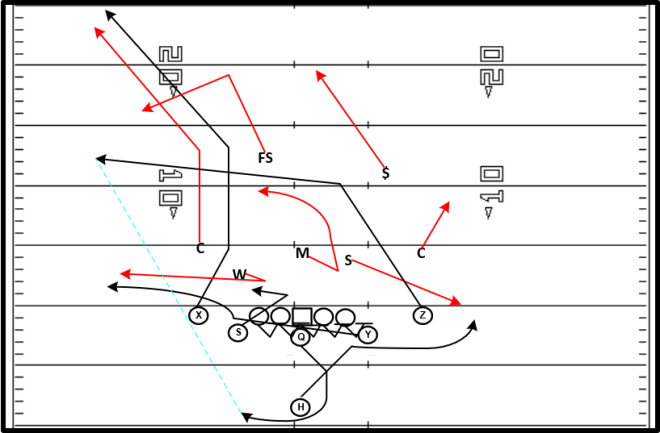
(Video 101)
Although the corner route is technically supposed to be the quarterback’s third read in the progression on the concept, often times, the quarterback would look straight to the trail route if both the slide arrow and crosser were covered. If both of these routes were taken away, then the trail route was open the majority of the time as it works behind the slide route and underneath of the crosser. Due to the late release of the trail route, it was commonly forgotten by the defense and left uncovered providing the quarterback with a high percentage checkdown that should have good room for run after the catch.

(Video 102)
The only time the Rams hit the corner route on this concept was when it was ran near the goal-line. Since they are now on the goal-line, the outside receiver will stem inside and almost show like he is blocking before running the backline towards the corner of the end zone. Because of his inside stem, the corner took his eyes off of him and drove on the tight end in the flat allowing the quarterback to hit the corner route behind him.

(Video 103)
…
CHAPTER 5 (EXCERPT)
DROPBACK PASS GAME
…
2-MAN CONCEPTS & BACKSIDE TAGS
In the Rams 5-step passing game, they had 4 primary 2-man route concepts and 5 primary backside tags (2 of which were already discussed in the quick game section). They could mix and match how they paired these concepts together, but what remained constant is that they always started by reading the 2-man side and then worked back to the 3-man side. We’ll start by looking at their 5 backside tags, and then look at the 2-man concepts and finish with how they paired these concepts together.
…
After looking at these backside tags, we will now look at the concepts the Rams would use on the frontside of these concepts.
…
SMASH RETURN
This was a better concept for the Rams in 2017 (it was one of their best passing concepts that season), but nevertheless, was still a good concept for them in 2018.
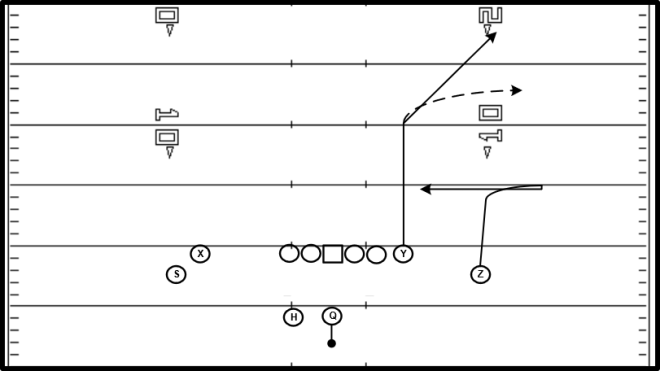
Hit Chart:
| Route | Attempts | Comps. | Yards | TDs | INTs |
| Return | 10 | 8 | 85 | 1 | 0 |
| Corner | 4 | 1 | 21 | 0 | 0 |
The primary route on this concept is the return route ran by the outside receiver. This is very similar to the return route discussed earlier in the backside tags section. The outside receiver will take a slight outside-stem and run a 4-step speed out, before pivoting back to the inside. The slot receiver will run a 10-yard corner route than can be flattened out if there is a defender playing over the top of him. The quarterback will read 1) return, 2) corner, 3) backside concept. This has been a very effective concept for the Rams against any match coverages where the alley defender carries the vertical release of #2 as he sees #1 break to the flat. If the vertical release of #2 is carried, the return route will work into the space created by the removal of this defender.

(Video 211)

(Video 212)
Against man coverage, both the return and corner routes give the offense good options to defeat man coverage.

(Video 213)
Against man coverage, the concept can also be helped by running it from a bunch formation. The shallow cross route ran by the point man (the Rams used the shallow-dig combination on the backside when running this concept from a bunch formation) should pull the point defender with him. With the outside receiver breaking initially breaking to the flat, this forces the inside defender to run with the corner route. Because of the distribution of the routes, the inside receiver should have outside-leverage on his corner route and the outside receiver should have inside-leverage on his return route.

(Video 214)
In their playoff game against Dallas, the Rams designed their smash return concept to look like their cross-shallow concept (discussed on pages 223-230). The shallow cross by #2, and the vertical stem by #3 looks very similar to their cross-shallow concept. The Cowboys were playing cover 3, but the corner came up on the return route, because he did not anticipate the corner route by #3.
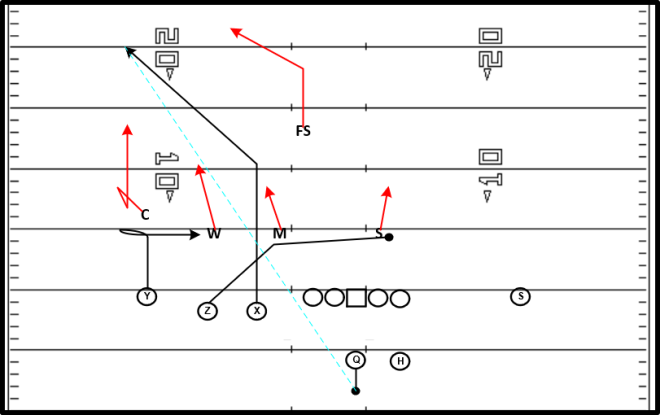
(Video 215)
In their week 3 matchup with the Chargers, the Rams ran an interesting version of the smash return concept near the goal line that played off of the 2-man stick concept that they scored on earlier in that game (see pages 213-214 to review this concept). This time, the outside receiver ran the corner and the inside receiver ran the return route. The outside receiver stemmed outside like he would on his stick route before breaking to the corner route. The inside receiver ran to the flat to mirror the arrow route he would run on the 2-man stick concept before pivoting back into the open space. After being beat on the 2-man stick concept earlier, the Chargers decided to have the corner play the flat and have the safety sit on the stick route. This left no one to cover the return route as the corner was sitting on the outside, and the safety ran with the corner route.

(Video 216)
As I mentioned before, the Rams could mix and match these concepts in a number of different ways. Below shows the diagrams for all of the different ways in which the Rams paired these concepts together. Each of the diagrams is only drawn in one direction, but the concepts could easily be flipped. (Note: The number in parenthesis shows how many times the pairing of the 2 concepts was used.)
…
SMASH RETURN
- BS Spot-Dig (12)

- BS Shallow-Dig (5)

…
Including what is shown here, the final book will include 350+ pages, 350+ diagrams, and over 250 videos posted to this site. The book will likely be released the weekend after the Super Bowl and will be available through Amazon for $25. Please contact me at TaylorKolste@gmail.com or @TaylorKolste on Twitter with any questions you have about the book.

I’d pay another $25 for the PlaymakerPro File you used to create these. I mean, since I’m going to have to redraw them in mine anyway. 😉 Thanks for all your work and you deserved to be paid for it!
LikeLike
Can I get Noah Riley’s email or some way to contact him about getting WSU vs. Cal 2014 ?
Regardless, thank you for reading.
LikeLike
@NoahRiley21 on Twitter/NoahBRiley@Lclark.edu
LikeLike